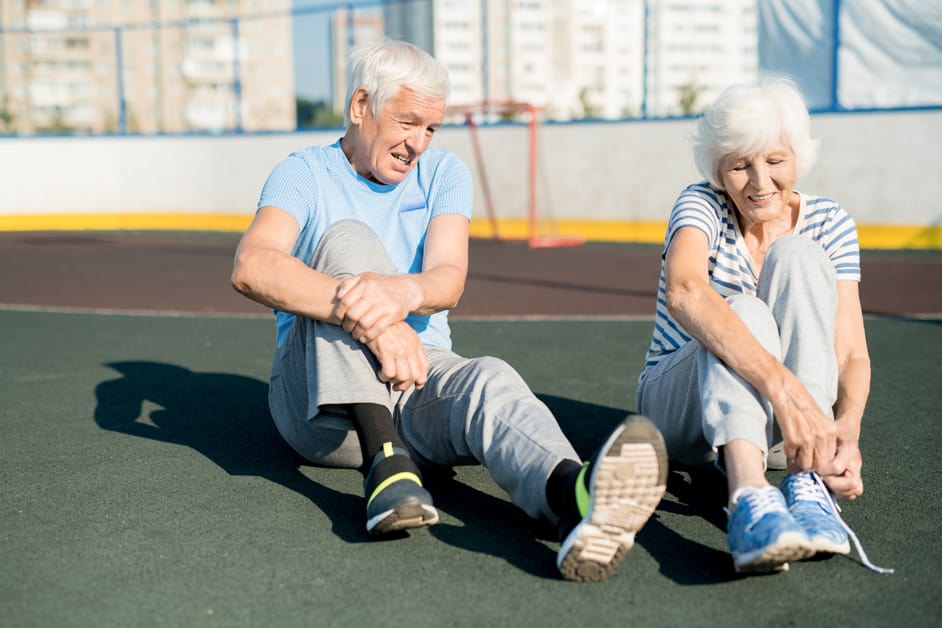Understand the Causes of Knee Pain
Knee pain can have various reasons. Age, lifestyle, injuries, and medical conditions may all influence it. To know which type of shoe can assist with the symptoms, it is crucial to recognize the source of your knee pain.
Let’s take a look at some of the common causes of knee pain and how that could affect your footwear choice:
Check for underlying medical conditions
Before treating knee pain, it’s important to consider if there is an underlying medical condition causing it. Possible causes include:
- Osteoarthritis: A joint disorder causing joint inflammation and pain.
- Rheumatoid arthritis: An autoimmune condition that affects multiple joints.
- Gout: Occurs when uric acid crystals deposit in the joints, causing severe pain.
- Bursae inflammation: Injury or overuse can lead to bursitis, which causes pain.
- Other conditions: Tendinitis, kneecap dislocation/fracture, fallen arches, obesity, or meniscus tears.
When diagnosing knee pain, your doctor will take a medical history and conduct a physical exam. X-rays may be taken to assess wear and tear in the joint. MRI scans may be requested to investigate ligaments and cartilage tears. Treatment options depend on the diagnosis and can range from rest and lifestyle changes to medications, injections, or surgery.
Identify the type of knee pain
It’s important to identify the type of knee pain you have. Generally, there are 3 kinds:
- Osteoarthritis. This is the most common and is usually seen in older people. It’s caused by joint cartilage breakdown, resulting in inflammation, joint pain, and stiffness.
- Soft tissue damage. Caused by sudden trauma or activities like running or jumping. Symptoms can include swelling, heat sensitivity, instability, and sharp pain with movement.
- Anterior Knee Pain Syndrome (AKPS). Common among young athletes, caused by running and jumping. Symptoms include swelling, tenderness, grinding sensations while flexing or extending the leg, and difficulty straightening the leg without feeling discomfort.
Choose the Right Shoe for You
Picking the ideal shoes when you suffer from knee pain is a must! The correct shoes can alter your knee pain management drastically. Let us go over the elements to think about when selecting shoes for knee pain. Then, you can find the perfect pair for you!
Elements to consider when selecting shoes for knee pain include:
- Comfort
- Stability
- Arch Support
- Shock Absorption
Consider the type of activity you’ll be doing
When choosing a shoe, think about what activity you’ll be doing. Feet move differently when running or playing lateral sports like basketball or tennis. Get a shoe that provides support and cushioning for your feet. Different materials provide cushioning and structure for different activities.
- For high-energy activities, get lightweight and breathable shoes.
- For outdoor activities, durable leather uppers can protect your feet.
- If you have foot conditions like flat feet or high arches, get shoes with orthotic inserts.
The right pair of shoes can help improve performance and reduce injury risk.
Consider the type of arch you have
Shopping for shoes? It’s important to think about your arch. The shape of your foot tells us which type of shoe is best for you. Shoes with different support for different arches are made by various manufacturers.
There are three types of arches: flat, normal and high. Flat feet have no arch, so it’s important to wear shoes with cushioning and arch support. People with normal arches should still choose shoes with some cushioning and arch support too. High-arched feet need a flexible sole and cushioning for shock absorption when walking or running.
Not sure what type of arch you have?
- Wet your foot and stand on a paper towel. You’ll see the shape created by the moisture.
- Or, go see an orthotics specialist, or ask a salesperson at a shoe store to measure your arch height and base width to figure out what type of shoes suit you best.
Look for shoes with cushioning and support
When shopping for shoes, pick styles with cushioning and support. This is key if you’re active or walk a lot. Cushioning absorbs shock from the ground, and supports evenly distribute weight, reducing strain and fatigue. Supportive shoes also keep feet in proper alignment, avoiding injuries.
Look for shoes with removable insoles. You can add custom orthotics for extra support. Running shoe models have air chambers and foam midsoles, to soften impacts from running or jogging. Shoes with reinforced toe boxes prevent stubbed toes and other impacts.
Find the Right Fit
Shoe shopping for knee pain? Don’t stress! You just need to find the perfect fit for your feet. Wrong size shoes can up the pain in your knees. So, let’s figure out how to get comfy, supportive and well-fitting shoes to reduce your knee pain. Here are the details!
Measure your feet
Measuring your feet regularly is key for the perfect fit. If you suffer from knee pain, it’s important to get the right size shoes with the right cushioning and support. When measuring, make sure your ruler or measuring tape is straight for accuracy.
Make sure to:
- Measure both feet – they may be different sizes.
- Ensure there is between a quarter and a half-inch between your big toe and the end of the shoe when trying them on.
- Take both length and width measurements before buying.
- Get an idea of whether standard sizes or special wide fits are suitable.
- Check for adequate support when trying on – use a heel cup if needed.
- Aim for shoes that fit comfortably without being too loose. This is especially true for delicate tasks like taking stairs.
- People with knee pain like arthritis should look for footwear with extra cushioning for relief.
Taking these precautions will ensure you can wear comfortable shoes and have long-term pain relief!
Make sure the shoe fits your arch
When searching for the perfect shoe, make sure it fits the arch of your foot. It should have two components: a cushion and an insole for support. The shape of the shoe should mimic the natural arch of the foot. Heel should fit securely, giving no discomfort on either side.
Pay attention to shoes meant for flat feet as they can reduce knee pain. Make sure there is sufficient gap between your longest toe and the end of the shoe. It is also important to try on both shoes as one foot can be longer than the other.
Make sure the shoe fits your heel
Start with a shoe that fits your heel. It should be secure and firmly cupped, with no wrinkles or creases. Make sure your ankles have enough support to stop them rolling in or out. You need a secure shoe that allows some freedom of movement.
Add cushioning at the heels. This provides shock absorption when you land. Avoid high heels or pointed toes as they put too much pressure on the ball of the foot. Look for shoes with rounded toes instead. This gives your toes some room, and helps to spread your weight evenly.
Lastly, make sure the shoe fits your size and shape. Don’t pick tight shoes that pinch, or ones that slip off. In person measurements will give you an accurate fit. If ordering online, measure both feet according to the store’s instructions.
Consider Shoe Material
Shoes and knee pain? Material matters! Leather or synthetic fabrics provide good support and reduce pressure on knees. Mesh or suede give more flexibility and cushioning. Let’s explore the different materials and their benefits:
Look for shoes made of breathable materials
When shopping for shoes for knee pain, consider the material. Shoes made of non-breathable materials can make feet sweaty and uncomfortable. Pick shoes made of breathable materials such as leather, mesh, nylon or canvas.
- Leather is great. It’s both durable and comfortable. It provides ventilation and keeps feet cool in warm weather. Leather wears well and is soft on skin.
- Mesh uppers are good for breathability. Air circulates easily and there’s a layer of protection against wind, debris and moisture. Mesh uppers are lightweight and easy on tired feet, but may not last as long.
- Nylon and canvas are lightweight alternatives that provide breathability. They bend with ease for maximum flexibility. Make sure the upper fits properly around the heel so it doesn’t rub against the back of the knee.
Look for shoes with shock-absorbing midsoles
Finding the perfect shoe for knee pain can be tricky. Investing time to research the materials and features that offer maximum comfort and protection is worth it. Knee health experts suggest looking for shoes with soft midsoles made of flexible foam. It compresses and decompresses with each step, minimizing harsh impacts on your knees. High-density ethylene vinyl acetate (EVA) foam is a good choice as it is softer than other types of foam midsoles. The midsole should feel bouncy. If not, move on.
Many shoe manufacturers now offer cushioned insoles made of silicone gel. They reduce impacts on your knees without making the shoes thicker or heavier. Some companies even developed technology with air pockets that inflate when compressed to cushion impacts.
Remember to look for supportive soles that provide all day comfort and reduce shock on your feet and knees while moving.
Consider the weight of the shoe
Shoe weight matters when it comes to comfort. Heavier shoes can be hard on your knees, so if you experience knee pain, you should go for a lighter material. Leather and fabric weigh less than synthetics but may not last as long and offer less support.
For lightweight yet supportive shoes, rubber is a flexible option. Soles also often use lightweight foam for breathability and cushioning.
Choosing the Right Insoles
Treating knee pain? The right insoles are key! They cushion, support, and reduce stress on the joints, ligaments, and bones. Pain relief, stability, and shock absorption can all be helped. But, what’s the best kind of insole for knee pain?
Here’s the scoop: Different types of insoles are out there. How to find the perfect pair? That’s the question!
Consider the type of arch support you need
Selecting insoles? Think arch support. Most manufacturers divide it into three types: low, medium, and high. Match to your feet size and shape. High arches? Rigid support helps with stability when walking. Low arches? Look for cushioning for comfort and pain relief.
Be aware that arch needs may change over time. Insoles can wear and lose their shape, needing replacement. When trying shoes in store, remove the manufacturer insert. Try on shoes with different insoles to get an idea of how they feel before buying:
- Low arch – cushioning for comfort and pain relief.
- Medium arch – balanced cushioning and support.
- High arch – rigid support for stability.
Look for insoles with cushioning and support
Cushioning and support are crucial when it comes to finding the perfect insole. Many insoles fit inside different shoes, offering extra cushioning and a supportive base.
When buying insoles, opt for materials like polyurethane or EVA for durability and cushioning. There are also higher-end options featuring patented technologies like GelSpan and AirPed, from leading brands like Superfeet. These provide extra arch support and contour to the shape of your feet, giving additional support with each step.
Consider insoles with shock-absorbing technology
When thinking about insoles for your shoes, look for ones with shock-absorption tech. Experts say it’s essential for good foot health. It stops the impact from each step from going up through your leg muscles.
Insoles aren’t all the same: some have air cushioning, gel cushioning, and EVA foam cushioning. There are also insoles with extra heel support, for better balance and stability. Whichever insole you buy, make sure it fits your shoes. That way, it will reduce stress on your feet, yet still be comfy.
Frequently Asked Questions
Q: What are the best shoes for knee pain?
A: Shoes with a cushioned sole, plenty of arch support, and a low heel are the best shoes for reducing knee pain. Shoes with a wide toe box are also beneficial for those with knee pain.
Q: How should I choose the right shoes for knee pain?
A: When selecting shoes for knee pain, look for a pair that has a good cushioning system, plenty of arch support, and a low heel. Additionally, look for shoes with a wide toe box to give your feet enough room to breathe. Avoid shoes with a narrow toe box, as this can cause further discomfort and pain.
Q: What materials should I look for in shoes for knee pain?
A: Look for shoes made of soft, breathable materials. Leather and suede are great for providing support and cushioning, while mesh and other lightweight fabrics are great for providing breathability. Avoid rigid materials that don’t provide cushioning or support.





